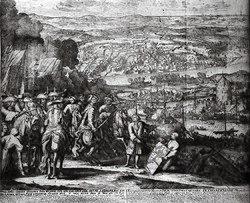Azov
47°6′N 39°25′E / 47.100°N 39.417°E
Azov (Russian: Азо́в, IPA: [a'zof]) is a town in Rostov Oblast, Russia, situated on the Don River just sixteen kilometers from the Sea of Azov, which derives its name from the town. Its population is 82,090 (2002 Census); 80,297 (1989 Census).
Early settlements in the vicinity
The mouth of the Don River has always been an important commercial centre. At the start of the 3rd century BCE the Greeks from the Kingdom of Bosporus founded a colony here, which they called Tanais (after the Greek name of the river). Several centuries later the settlement was burnt down by king Poleumon of Bosporus. The introduction of Greek colonists restored its prosperity, but the Goths practically annihilated it in the 3rd century. The site of ancient Tanais, now occupied by Nedvigovka village, has been excavated since the mid-19th century.
In the 10th century, the area passed under control of the Slavic princedom of Tmutarakan. The Kypchaks, seizing the area in 1067, renamed it Azaq (i.e., lowlands), from which appellation the modern name is derived. The Golden Horde claimed most of the coast in the 13th and 14th centuries, but the Venetian and Genoese merchants were granted permission to settle on the site of modern-day Azov and founded there a colony which they called Tana. Later, the Ottoman Empire gained control of the area and built the strong fortress of Azak (Azov).
Fortress of Azov

In the summer of 1637 the Don Cossacks captured the fortress with its Turkish garrison of 4000 soldiers and 200 cannons and held it for 5 years. In June 1641 they withstood a long siege by an Ottoman army. In 1642, when the Turks retreated, the Tsar summoned a popular assembly, or Zemsky Sobor, which decided to surrender the fortress in order to avoid the full-scale war with Turkey. Before leaving the castle, the Cossacks annihilated all the fortifications.

The town, however, had yet to pass through many vicissitudes. During the so-called Azov campaigns (1696), Peter the Great managed to recover the fortress,[1] but the disastrous Pruth Campaign constrained him to hand it back to the Turks in 1711. A humorous description of the events is featured in Voltaire's Candide. During the Great Russo-Turkish War it was taken by the army under Count Rumyantsev and finally ceded to Russia under the terms of Treaty of Kuchuk-Kainarji (1774). For seven years Azov was a capital of a separate government but, with the growth of neighbouring Rostov-on-the-Don, gradually declined in importance.
See also
External links
Notes
- ^ Lord Kinross, The Ottoman Centuries: The Rise and Fall of the Turkish Empire, Perennial, 1979, p. 353. ISBN 0688030939.
